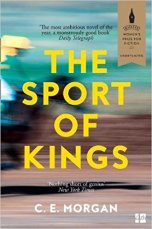During the Christmas holiday this idea popped into my mind: how about following an online course about literature? After a short research, I realized that most literature courses were too advanced for what I was looking for … so at that moment I gave up looking. But a few days ago I discovered BookJotter and Paula’s posts about the online course How to Read a Novel from The University of Edinburgh. Needless to say, it is exactly what I was looking for!
Without further ado, let me tell you what I learnt during the first week of the course!

§ The difference between story and plot: the story is the chronological order of events (the what), while the plot focuses more on causality (the why). A famous example given by E.M. Forster is the following:
Story: the king died and then the queen died (the what)
Plot: the king died and then the queen died of grief (the why)

§ About flashbacks and flash-forwards: “strategies that authors use to interrupt or complicate the smooth organisation of time in their novels“. We can think of authors as masters of time!
To illustrate these 2 concepts, the professor used as examples paragraphs from Virginia Woolf’s novel, “Mrs. Dalloway”. Now this book is on my to-be-read list 🙂
§ The pace of a novel: another decision related to plotting, this time about slowing down or accelerating the passing of time. For example, Marcel Proust is one of the most famous writers using the slowed down style, with his well-known novel “In Search of Lost Time”.

An example of speeding up the action can be found in Virginia Woolf’s novel “To the Lighthouse”, in the middle section, where “an entire decade takes up less than 20 pages”. In contrast, the first part and the last part of the book each present 1 day. One more book on my to-be-read list 🙂
§ Framed narratives: some writers use gaps in the plot – “those aspects we feel are being kept from us, the result either of some sort of structural difficulty with accessing the story, or of a narrator whom we feel we cannot trust“. An interesting example of a framed narrative is “Frankenstein” by Mary Shelley, a novel entirely composed of letters written by one man to his sister.

Also related to framed narratives, the professor used an insightful metaphor that I liked a lot: “think of this [framed narratives] as a series of concentric circles enveloping the main plot, making it progressively more difficult for the reader to reach the truth at its core. Because more than simply providing us with another layer of narrative, what each of these frames also does (certainly in the case of Mary Shelley’s novel), is bring their own personality and prejudices to bear on the story it encloses“.
§ Free indirect style: this is a narrative perspective technique whereby something is presented from the third-person narrator, but in fact, it is modified and adapted to the individual perception and observation of a certain character, also explained as “a process of intermingling takes place between character and narrator“. I think I read many novels that used free indirect style, but until now I was not particularly aware of this technique.
It is also interesting to think that the author might actually try to trick his/her readers by using a potential-doubtful narrator … distorting certain aspects of the story and presenting a subjective point of view on events. Been there, read that!

The book proposed to better understand the above-mentioned techniques is “The Sport of Kings” by C. E. Morgan. According to the course professors, this novel has many examples of flashbacks and flash-forwards, deceleration and acceleration moments, as well as different narrative voices.
After a successful and really interesting first week, I am much looking forward to the next classes! If you’re also taking this course, please let me know. If you’re not taking it, I recommend you check their website … you might get inspired to hop on this journey 🙂
Later edit: check out week 2 here.
‘Till next time … happy reading!
Georgiana
PS: the first week of the online course How to Read a Novel from FutureLearn.com contains also other aspects I did not mention here. The full course content can be found on this website.
Images: Amazon.co.uk | Amazon.co.uk | Pinterest.com | Pinterest.com | Cover picture by Annie Spratt on Unsplash


Thank you so much for the mention. I’m so pleased you signed up for the course and even more delighted to learn you’re enjoying it so much. I will follow your posts with interest! 😊
LikeLike
Thanks, Paula! I am also excited to continue the online course, it’s been great so far! 😀
LikeLiked by 1 person